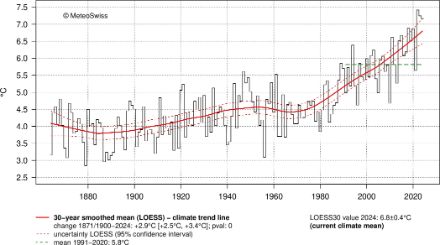Service Navigation
Search
To calculate climate warming in Switzerland, today’s average temperature is compared with that of the pre-industrial reference period 1871-1900. However, looking at the temperature trends measured across the country in recent decades, it is striking how quickly warming has progressed since the 1980s – almost half a degree every 10 years. So what is the average temperature today?

If we use the mean value of a current period (e.g., the reference period 1991–2020 or the last 20 years) to describe today's climate, we are constantly lagging behind the true value due to ongoing warming. This is because the current climate, 10–15 years after the midpoint of the periods used, is already significantly warmer. This also means that the value we obtain for warming since pre-industrial times is too low.
MeteoSwiss, in collaboration with other weather services, has developed a method for determining the current climate that takes rapid warming into account. This involves fitting a climate trend line to the data that corresponds as closely as possible to a 30-year average (WMO standard period) at each point and represents the climate trend over time. Since this climate trend line extends to the end of the data series, the current (today’s) climate mean can be read at the end point.
It appears that shortly after the end of the WMO reference period 1991–2020, the climate in Switzerland was already several tenths of a degree above the average of that period (e.g., by 1°C in 2024). This progressive warming can and must be taken into account if the warming since pre-industrial times is to be determined as accurately as possible.
Using this approach, the warming in Switzerland since pre-industrial times is calculated as the difference between the current climate mean and the pre-industrial reference period 1871-1900. The calculated warming is given as a mean value with a range of uncertainty. The larger uncertainty of the endpoint of the climate trend line is taken into account when calculating the historical warming and the uncertainty range.